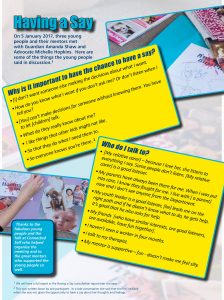
26 July 2016
Here are seven things that young people in care told us while discussing ‘Having a Say’ at our youth consultation last week. 1
1. I do need to talk with you. I need to let you know what is important to me, to get what I want and need and to be kept safe.
2. Some ways of communicating with me don’t work:
- suggestion boxes are not private and sometimes nothing happens
- certificates and awards can be nice but I might not like being singled out and paraded in front of everyone
- I’m not going to share my feelings at house meetings if everyone is having a go at each other
3. I have ways of sending messages to you, that you may not understand, for example:
- I may have my earbuds in but this is not always to listen to music. It can also be so I am left alone or so I can avoid joining in before I am ready
- I may be dismissive but that’s because I am still working out what is going on and if I can trust you
- I may be quiet and withdrawn for the same reason
- I may tell you how I am feeling by what I wear
4. I may find it easier to use pictures rather than words:
- pointing at emoticons on cards or posters can tell you how I’m feeling without words
- I can tell you things about myself and my life with my camera
- I can show you things about myself from my Life Story Book
5. I can have a say most easily with people I know and trust and with whom I have a relationship.
6. I am not the same as every other young person in care.
7. I need you to understand where I have come from and how I am dealing with this situation so that you can understand me when I have a say.
Please share your insights and experiences with us in the reply space below.
1 These are not all the exact words of the young people but as respectful and faithful a representation of their intent, as we can make it. Huge thanks to the seven young people who shared and showed us so much last week. Also thanks to the management and staff of HYPA for their help in putting the consultation together.
This item was also published in the August 2016 Guardian’s Newsletter.
.

2 Responses
I am an Art Therapist with many years experience of working with children and young people. Statements made in number 4 are an important illustration of the power that art has in being able to speak for young people. It is a non threatening and liberating way for young people to communicate how they are feeling and to gain insight about themselves. As PabloPicasso said “Art washes away from the soul the dust of everyday life”.
When there was a placement crisis for one of my young people, we decided to go to the zoo for the day. I had my camera, so shared it for the occasion – an unusual opportunity to spend relaxed time together. As we walked, we talked about what she was seeing through the lens. I found out so much more than I could ever imagine about this young person’s feelings and values when she talked about how the animals appeared to her and what she saw in their behaviour through the lens (we had a tele as well as normal lens). Through her patience, she clearly connected to the animals and birds in many of the photos, not just took a photo. She’s so proud of the results, and they’re all in an album now for her to recall and share however and whenever she wants. And it has changed how she shares with me – it’s such a comfortable experience. [name withheld on request – Families SA Worker]